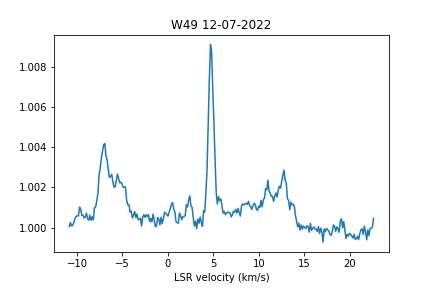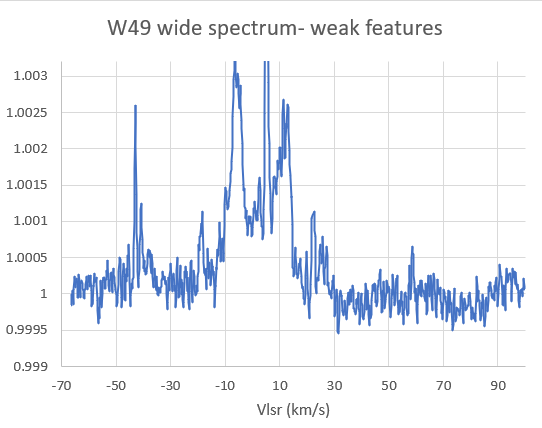W49 capturing problems
11 views
Skip to first unread message
Michiel Klaassen
Aug 1, 2022, 1:04:44 PM8/1/22
to camras-forum, sara-list
Hi All,
Just a short note on my trials to capture water masers.
I use the Norsat 9000LDF; however it uses a DRO for the LO; so it drifts with temperature. I tried to stabilize it by adding a linear thermostat. Not an on/off version, but one that adds power in a linear way.
I have given up trying to control the temperature over 24H when the temperature varies between 16 and 40 degree air temperature. When the solar rays hit the feed, the temp will rise even more.
The LNB consumes about 2W and the temp control adds 0 upto 5W during the evening cool down.
Also I extended the frequency range of the capturing process. As an example; W49 has an extended velocity range; that means that in the young stellar object a lot of high velocity movements are present.
You can check this by looking into the maser dbase; https://maserdb.net/ and search for W49.
Some results show VLsr of -100 to +100 km/s.
This cannot be captured with a 2,4MHz wide dongle.
So I wrote a python script for frequency hopping. Advantage is that the signal is always present, you just pick a section of the range and integrate; then the next section.; etc.
Attached is 12MHz wide plot.
Remarkable is; the peak at -5km/s is gone. Before anyone thinks something alien, an explanation is that this is a masing cloud circulating a protostar (a warm blob); it could be detected again after a complete rotation.
I will add a project tab again to parac,eu and give more details and downloads.
Regards,
Michiel
parac.eu
Just a short note on my trials to capture water masers.
I use the Norsat 9000LDF; however it uses a DRO for the LO; so it drifts with temperature. I tried to stabilize it by adding a linear thermostat. Not an on/off version, but one that adds power in a linear way.
I have given up trying to control the temperature over 24H when the temperature varies between 16 and 40 degree air temperature. When the solar rays hit the feed, the temp will rise even more.
The LNB consumes about 2W and the temp control adds 0 upto 5W during the evening cool down.
Also I extended the frequency range of the capturing process. As an example; W49 has an extended velocity range; that means that in the young stellar object a lot of high velocity movements are present.
You can check this by looking into the maser dbase; https://maserdb.net/ and search for W49.
Some results show VLsr of -100 to +100 km/s.
This cannot be captured with a 2,4MHz wide dongle.
So I wrote a python script for frequency hopping. Advantage is that the signal is always present, you just pick a section of the range and integrate; then the next section.; etc.
Attached is 12MHz wide plot.
Remarkable is; the peak at -5km/s is gone. Before anyone thinks something alien, an explanation is that this is a masing cloud circulating a protostar (a warm blob); it could be detected again after a complete rotation.
I will add a project tab again to parac,eu and give more details and downloads.
Regards,
Michiel
parac.eu
Eduard Mol
Aug 2, 2022, 3:50:32 PM8/2/22
to camras...@googlegroups.com
Hi Michiel,
Nice result again.
I noticed that results are better when observing at nighttime, probably due to more stable temperatures.
Below you can see my most recent spectrum of W49 from July 12. The peak at -5 km/s was already quite weak at that date.
These water masers seem to be highly variable at very short timescales.

I will soon try to make a spectrum with a wider velocity range just like you did, using my 1 metre dish.
Best regards,
Eduard
Op ma 1 aug. 2022 om 19:04 schreef Michiel Klaassen <vmin...@gmail.com>
--
Je hebt dit bericht ontvangen omdat je bent geabonneerd op de groep 'Camras-forum' van Google Groepen.
Als je je wilt afmelden bij deze groep en geen e-mails van de groep meer wilt ontvangen, stuur je een e-mail naar camras-forum...@googlegroups.com.
Ga naar https://groups.google.com/d/msgid/camras-forum/CAABBjRA370%2B3cTLvOpNURpSw7xLd0yvuf9pLg9DUW7c4i9FeDA%40mail.gmail.com om deze discussie op internet te bekijken.
Eduard Mol
Aug 7, 2022, 6:08:41 AM8/7/22
to camras...@googlegroups.com
Hi Michiel,


Last night I made a 12 MHz wide spectrum just like you did. It is composed of six spectra with 10 minutes integration time each. In general our results seem to match quite well.

There seem to be several weaker high velocity features, at -43, -41, -18, +22 and +58 km/s. I have missed these peaks before, because I usually make a spectrum of the main peaks between -10 and +20 km/s.

jobgeheniau
Aug 7, 2022, 6:33:53 AM8/7/22
to Camras-forum
Very nice Michiel! (and Eduard also of course).
The idea of splitting samples for a larger range is indeed a good solution.
Maybe I am gonna try that at 1420 MHz for trying to get Andromeda in the big range it needs.
Job Geheniau
Op zondag 7 augustus 2022 om 12:08:41 UTC+2 schreef eddiemol2000:
Reply all
Reply to author
Forward
0 new messages
